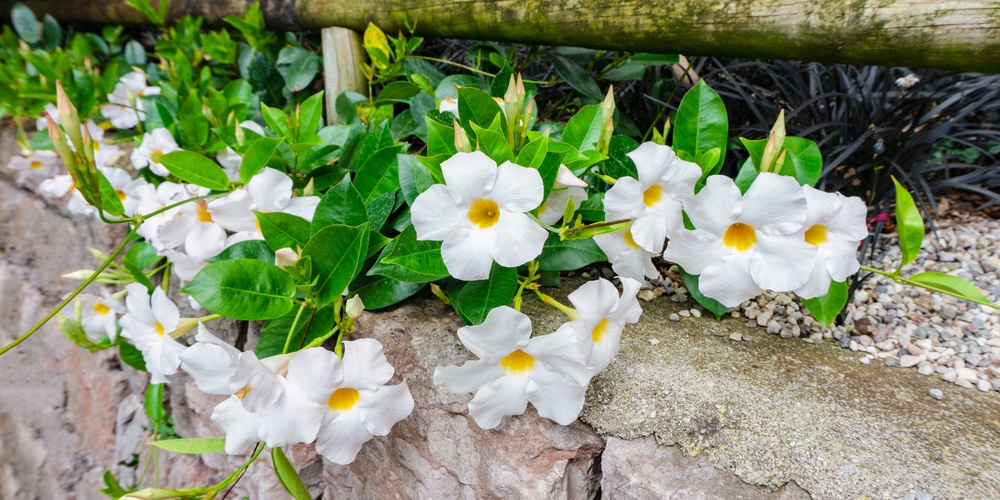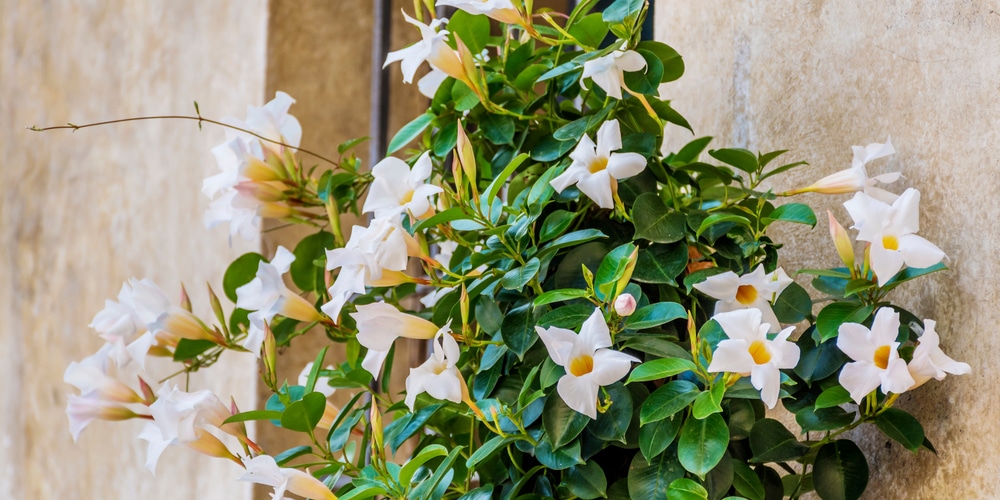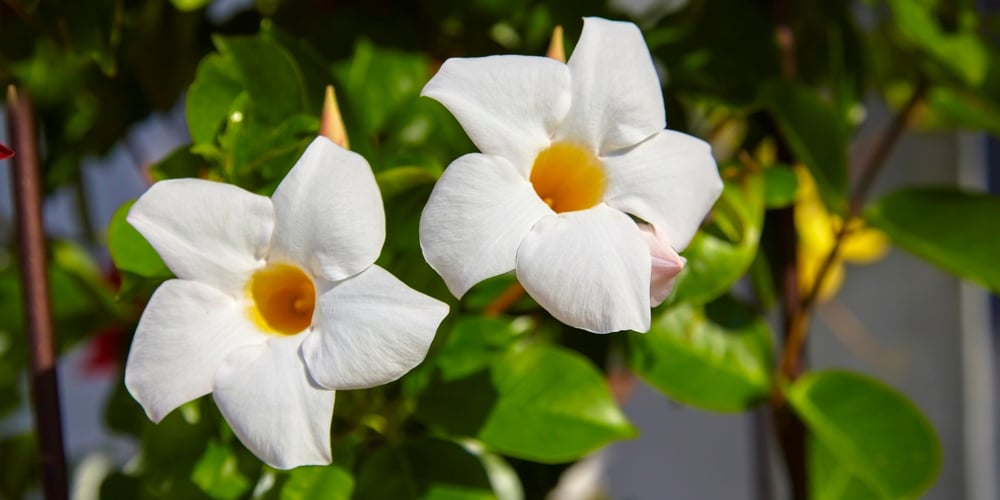White Mandevilla (Mandevilla spp) is a beautiful tropical flowering plant. It has small, dark green leaves and white trumpet-shaped flowers that can grow up to 10 feet high in the right conditions (although it’s usually kept more compact). The White Mandevilla also climbs so make sure you have something sturdy for support!
The plant can be grown in containers or trained to grow on trellis or walls with support. They also make beautiful potted plants that can grow indoors or outside. Proper care of the plant is paramount for its healthy growth and continued flowering. Let’s look at how to grow and care for a White Mandevilla plant.
What is a White Mandevilla plant?
Mandevilla is a versatile plant that can be grown indoors and out. It’s also attractive enough to serve as an accent in your home, office or classroom! The white variety has long been cherished by those looking for beauty among other things such as medicinal value (it relieves stomachache). Let me show you how easy it is to take care of these plants so they continue rewarding you with flowers all year round – without much effort on your part either way:
These plants grow in tropical and sub-tropical climates that originate from Central and South America. The White Mandevilla has thick woody stems and dark green foliage. It is closely related to the Red Mandevilla.
Flowers usually appear in the summertime when day and night temperatures are warm. White Mandevilla’s can be grown outside in USDA zones 9 to 11. These plants may become dormant if left outdoors in winter in zone 9. If you live in colder regions, you can also grow this plant indoors and move it to a sunny patio or balcony in the summer.
How to care for a white Mandevilla plant

The plant can be grown both indoors and outdoors as a potted or climbing plant. They require bright sunlight for healthy growth but will tolerate partial shade during the day. The soil should be well-drained and allowed to dry slightly between watering. Here are some tips to help you care for a White Mandevilla plant:
Sunlight needs
The White Mandevilla plant prefers bright sunlight but can tolerate partial shade during the day. If you’re keeping your Mandevilla as a houseplant, you should ensure it’s placed on a bright, sunny windowsill so that it gets enough light. These plants need between 6 and 8 hours of sunlight a day to thrive. They can also be grown under a fluorescent light indoors.
Watering requirements
White Mandevilla plants need moderate amounts of water, especially in warmer areas. Water thoroughly to moisten all soil and then allow it to dry slightly before watering again. The leaves will droop when over watered, and root rot may occur, so it’s always best to test the soil with your finger to see if your plant needs water.
Fertilization
Fertilize your plant every month with a balanced fertilizer. Do not feed it too much, as this will result in leggy growth and poor flowering. Alternatively, use a slow-release fertilizer that can be given to your plant twice annually in the spring and fall.
Soil
Use a light, well-drained potting mix to grow your plant in containers. You can also use readymade garden soil mixed with organic compost, vermicompost, and aged manure. Repot in spring after flowering using a well-drained soil mix. White Mandevilla plants prefer soil with a pH range of between 6.6 to 7.8. They can cope with soil that’s neutral or slightly acidic, or alkaline.
Repotting and pruning
Prune any broken stems with a sharp knife or secateurs. You can also cut the plant back by 1/3 if it’s getting too large. White Mandevilla plants can cope with heavy pruning. Pruning will help to encourage your plant to become bushier.
Pests and diseases
White Mandevilla plants are susceptible to pests such as scale, mealybug, whitefly, and aphids. Other diseases include leaf spot, root rot, and crown gall. Treat any disease with appropriate fungicides or insecticides as per package directions. Also, make sure you use safe pesticides for your plants to avoid killing them.
Temperature
White Mandevilla plants grow well in moist, warm weather during the day and a little cooler at night. Ideal temperatures are 60 to 70 Fahrenheit during the day and 40 to 50 Fahrenheit at night.
When the temperatures fall below 50F, you can overwinter your plant by bringing it indoors or moving it into a greenhouse. As White Mandevilla plants are tropical, they aren’t very cold hardy and shouldn’t be left outside in cold weather, particularly if frost is expected. Here’s our guide to taking care of a Mandevilla plant in the winter.
Humidity
Higher humidity of around 70 percent is preferred for good flowering. If you live in a dry area, you can use a tray with pebbles and water to improve humidity. AS the water evaporates, it will provide your plant with moisture. Alternatively, spray your plant’s leaves lightly using a fine mist. Be careful not to soak the leaves, especially not the flowers, as this can cause fungal infections to develop. Other ways to improve humidity for your plant is to group it with other tropical species or invest in a humidifier.
How to propagate new White Mandevilla plants
Start with taking cuttings of healthy vines in the early spring. It’s best to use sterilized scissors when taking cuttings. Cuttings should be between 4 and 6 inches long.
Prepare a garden bed by digging it up and adding aged manure or compost. Dip the end of the cuttings in rooting hormone and then plant in the prepared garden bed. Water well until new growth appears.
Keep your plant clean by removing dropped leaves or flower petals daily. Clean up any spills around the pot with a wet cloth to prevent fungal infections.
Conclusion
White Mandevilla plants are perfect for those who want to clean up their home without spending too much time or money on decor. The vines can grow both indoors and outdoors, though they do best in sunny locations with ample watering opportunities throughout the day so you don’t have dry leaves when night falls. Be sure not to let water sit in its own footprint because this will decrease air circulation around roots which could lead toward root rot problems down the line.

